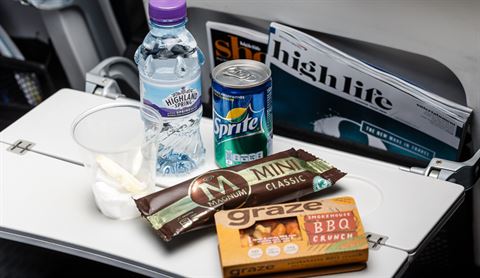BA PEOPLE • March 2018
The Guru: how to devise a menu at 35,000ft
Following the launch of British Airways’ new World Traveller menu, The Club speaks to Mark Tazzioli, the airline’s chef and menu design manager, who shares his thoughts on creating top-notch on-board dining
What are your priorities when you design a new menu?
We’ve been building on the customer feedback that we’ve had to make some changes to World Traveller, such as including a second meal or substantial snack (depending on the length of the flight), adding a tuck box with chocolate and biscuits, and including some more well-recognised brands. It’s been a good chance to redesign in line with the Club World investment.
What are some of the limitations that you face with serving food at altitude?
We have to allow for the fact that around 30 per cent of people lose the ability to taste well at altitude, so we use robust flavours, and ensure they have enough moisture so they don’t dry out when reheated. We have space limitations as well, so meals must be able to fit on the aircraft, and within the specification to fit in the oven.
How does this affect your creativity when you draw up a menu?
We have to use creativity carefully, and a lot of this is around flavour and taste. Last year, we remade a lot of our sauces and adjusted recipes so they taste better in the air – much of which requires looking at the science of the food and the logistics behind transporting it.
What sorts of flavours work best?
Anything spicy works well in the air. Chicken tikka masala and butter chicken are popular, and this winter we’re doing braised beef dishes that don’t dry out when they’re reheated. Our smoked salmon is also specially cured for us with a slightly stronger smoke so that the flavour isn’t lost at altitude. For vegetarians, we have pasta dishes with strong sauces, such as tomato bases or wild mushroom, which is strong in umami, a naturally occurring salt substitute without the sodium. We’ve also developed Thai and South Indian vegetable curries which work well.
How do you decide on the brands that you bring on board?
We look for recognisable names, and great products, that fit with the British Airways brand. Magnum is very well known as a popular ice cream, and Graze is a healthy snack brand, which has really grown in popularity over the past few years.

The perfect cinema snacks, courtesy of Graze and Magnum
How do you decide which regional and classic dishes to offer?
We look at a route’s passenger profile and design the number of regional dishes that we offer in line with this. We also invite chefs from those destinations to spend time working with us in London. When the chefs are here, we design two years’ worth of dishes in a workshop, before testing them with international crew.
Are there any trends around dining onboard at the moment?
We’ve seen more passengers interested in eating fish, and less in red meat. We’ve also seen a lot more interest in gluten-free as a lifestyle choice, so we try to offer more options in Club Kitchen, where customers can help themselves to snacks in the galley. We’ll also be relaunching our special meals with more options that contain more information for passengers.
What’s the most popular dish?
Indian food is always popular, no matter what!
As told to Marisa Cannon
Find out more about on-board dining at ba.com
This article has been tagged Food + Drink, BA
